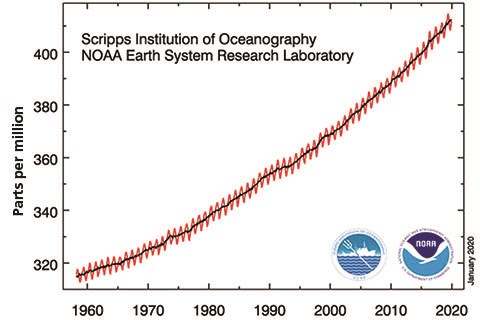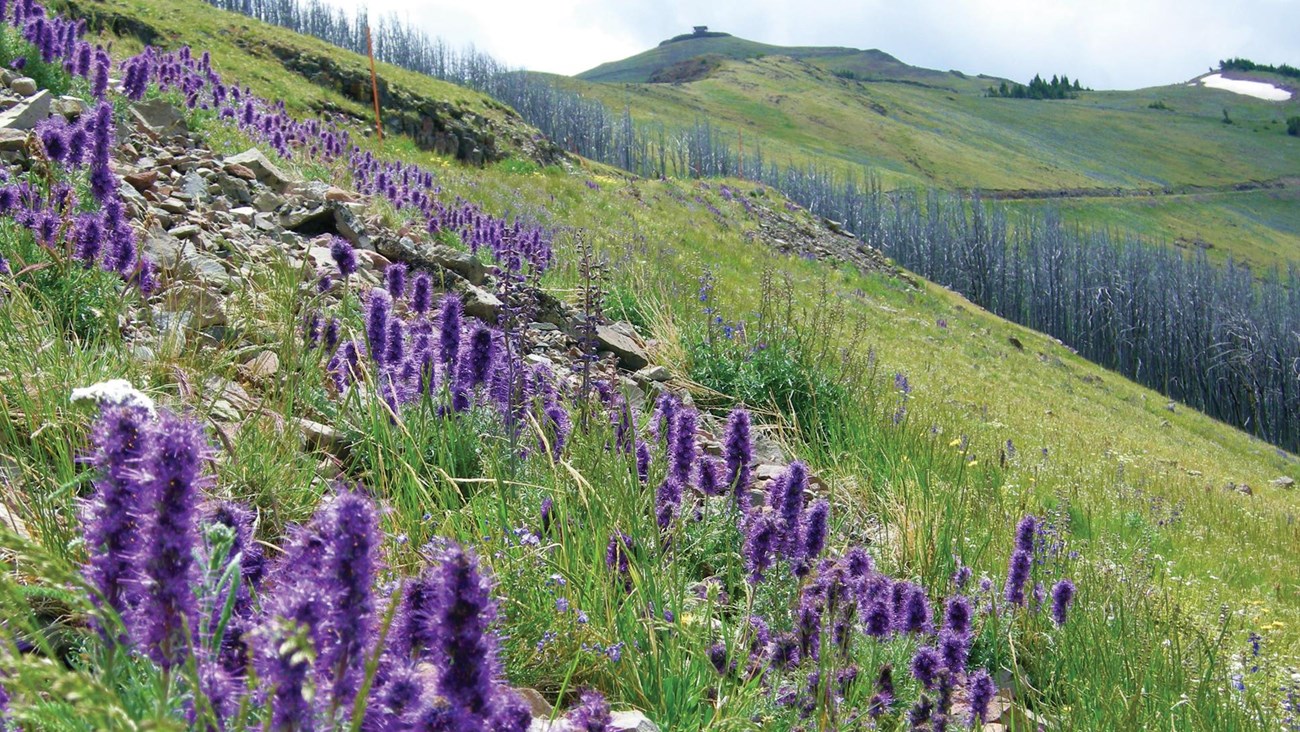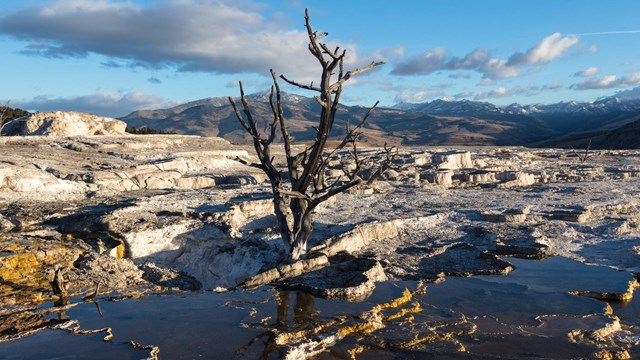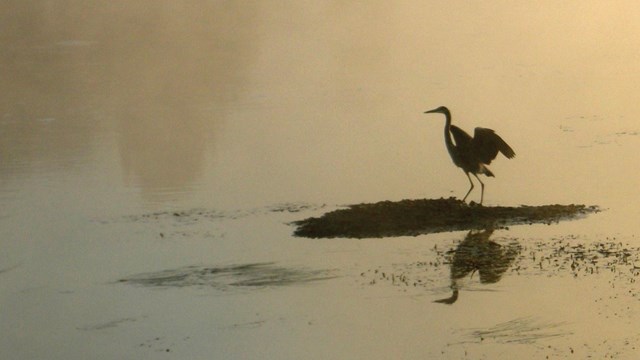|
Visit our keyboard shortcuts docs for details
Snowfall in Yellowstone melts into rivers that span the continent from the Gulf of Mexico to the Pacific Ocean. Scientists are documenting significant changes in the amount of snow that falls here as well as the intensity and timing of spring runoff. These trends could affect everything you see when you come to the park, as well as everyone and everything living downstream. 
Today, climate change is no longer a vague threat in our future; it is the changing reality we live with, and it requires continuous planning and adaptation. Climate change presents significant risks to our nation’s natural and cultural resources. Though natural evolution and change are an integral part of our national parks, climate change jeopardizes their physical infrastructure, natural and cultural resources, visitor experience, and intrinsic values. Climate change is fundamentally transforming protected lands and will continue to do so for many years to come. Climate change will affect everyone’s experience of our national parks. Some effects are already measurable. Warmer temperatures are accelerating the melting of mountain glaciers, reducing snowpack, and changing the timing, temperature, and amount of streamflow. These changes are expected to result in the loss or relocation of native species, altered vegetation patterns, and reduced water availability in some regions. Wildfire seasons have expanded, and fires have increased in severity, frequency, and size. More acres burned in the fire season of 2016 than in any year in the last century, except for 1988. Conditions that favor outbreaks of pests, pathogens, disease, and nonnative species invasion occur more frequently than in the recent past. In Alaska, melting sea ice threatens marine mammals as well as coastal communities, while thawing permafrost disrupts the structural basis of large regions, jeopardizing the physical stability of natural systems as well as buildings, roads, and facilities. Rising sea levels, ocean warming, and acidification affect wildlife habitat, cultural and historic features, coastal archeological sites, and park infrastructure, resulting in damage to and the loss of some coastal resources. Some studies suggest that extreme weather events such as thunderstorms, hurricanes,and windstorms that damage park infrastructure and habitat are increasing in frequency and intensity. Climate change will manifest itself not only as changes in average conditions, creating a “new normal,” but also as changes in particular climate events (e.g., more intense storms, floods, or drought). These extreme climate events may cause widespread and fundamental shifts in conditions of park resources. A 2014 assessment of the magnitude and direction of ongoing climate changes in Yellowstone National Park showed that recent climatic conditions are already shifting beyond the historical range of variability. Ongoing and future climate change will likely affect all aspects of park management, including natural and cultural resource protection as well as park operations and visitor experience. In order to deal with the predicted impacts, effective planning and management must be grounded in concrete information about past dynamics, present conditions, and projected future change. 
Changes in Yellowstone Climate
Scientists with the National Park Service and other organizations closely monitor variables that may reflect a changing climate. 
Climate Change Explorer
The Climate Change Explorer is a tool that compares past averages to future predictions for variables in the Greater Yellowstone Area. 
Examining the Evidence
Climate change is predicted to cause birds to shift their range, migratory patterns and timing, and interfere with reproduction. ResourcesAl-Chokhachy, R., J. Alder, S. Hostetler, R. Gresswell, B. Shepard. 2013. Thermal controls of Yellowstone cutthroat trout and invasive fishes under climate change. Global Change Biology 19, 3069–3081, doi: 10.1111. Allen, C. D., A. K. Macalady, H. Chenchouni, D. Bachelet, N. McDowell, M. Vennetier, T. Kitz- berger, A. Rigling, D. D. Breshears, E. H. Hogg, and others. 2010. A global overview of drought and heat-induced tree mortality reveals emerging climate change risks for forests. Forest Ecology and Management 259:660–684. Anderson, C. (editor). 2011. Questioning Greater Yellowstone’s future: Climate, land use, and invasive species: Proceedings of the 10th Biennial Scientific Conference on the Greater Yellowstone Ecosystem. Yellowstone National Park, WY, and Laramie, WY: Yellowstone Center for Resources and University of Wyoming William D. Ruckelshaus Institute of Environment and Natural Resources. Anderson, L., C. E. Carlson, and R. H. Wakimoto. 1987. Forest fire frequency and western spruce budworm outbreaks in western Montana. Forest Ecology and Management 22:251–260. Bachelet, D., R. P. Neilson, J. M. Lenihan, and R. J. Drapek. 2001. Climate change effects on vegetation distribution and carbon budget in the United States. Ecosystems 4:164–185. Baril, L. 2015. Birds of the Molly Islands: The “boom and bust” nesting cycle turns “bust only.” Yellowstone Science 23(1). Bentz, B. 2008. Western US Bark Beetles and Climate Change. USDA Forest Service, Climate Change Resource Center. Available at https://www.fs.usda.gov/ccrc/topics/western-us-bark-beetles-2008. Bingham, B., M. Britten, L. Garrett, P. Latham, and K. Legg. 2010. Enhanced monitoring to better address rapid climate change in high-elevation parks: a multi-network strategy. Natural Resource Report NPS/IMR/NRR—2011/285. National Park Service, Fort Collins, Colorado. Brown, T. J., B. L. Hall, and A. L. Westerling. 2004. The impact of twenty-first century climate change on wildland fire danger in the western United States: An applications perspective. Climatic Change 62:365–388. Chang, T., and A.J. Hansen. 2015. Historic and projected climate change in the greater Yellowstone ecosystem. Yellowstone Science 23(1). Flannigan, M., B. Amiro, K. Logan, B. Stocks, and B. Wotton. 2006. Forest fires and climate change in the 21st Century. Mitigation and Adaptation Strategies for Global Change 11:847–859. Hansen, A., N. Piekielek, T. Chang, and L. Phillips. 2015. Changing climate suitability for forests in Yellowstone and the Rocky Mountains. Yellowstone Science 23(1). IPCC, 2013: Climate Change 2013: The Physical Science Basis. Contribution of Working Group I to the Fifth Assessment Report of the Intergovernmental Panel on Climate Change [Stocker, T.F., D. Qin, G.-K. Plattner, M. Tignor, S.K. Allen, J. Boschung, A. Nauels, Y. Xia, V. Bex and P.M. Midgley (eds.)]. Cambridge University Press, Cambridge, United Kingdom and New York, NY, USA, 1535 pp. Available at http://www.ipcc.ch/report/ar5/wg1/. Kelsey, R. G., and G. Joseph. 2003. Ethanol in ponderosa pine as an indicator of physiological injury from fire and its relationship to secondary beetles. Canadian Journal of Forest Research 33:870–884. Littell, J. S., D. McKenzie, D. L. Peterson, and A. L. Westerling. 2009. Climate and wildfire area burned in western U. S. ecoprovinces, 1916–2003. Ecological Applications 19:1003–1021. Logan, J. A., J. Regniere, and J. A. Powell. 2003. Assessing the impacts of global warming on forest pest dynamics. Frontiers in Ecology and the Environment 1:130–137. McKenzie, D., Z. Gedalof, D. L. Peterson, and P. Mote. 2004. Climatic change, wildfire, and conservation. Conservation Biology 18:890–902. McMenamin, S.K., E.A. Hadly, and C.K. Wright. 2008. Climatic change and wetland desiccation cause amphibian decline in Yellowstone National Park. Proceedings of the National Academy of Sciences 105(44):16988–16993. McWethy D.B., et al. 2010. Climate and terrestrial ecosystem change in the U.S. Rocky Mountains and Upper Columbia Basin: Historical and future perspectives for natural resource management. Natural Resource Report NPS/GRYN/NRR—2010/260. Available at http://www.fedgycc.org/wp-content/uploads/2015/06/McWethy_et_al_2010_NPS_NRR260_Climate_Terrestrial_Change_RockyMtns_UprColBasin.pdf. Negron, J. F., B. J. Bentz, C. J. Fettig, N. Gillette, E. M. Hansen, J. L. Hays, R. G. Kelsey, J. E. Lundquist, A. M. Lynch, R. A. Progar, and S. J. Seybold. 2008. USDA Forest Service bark beetle research in the western United States: Looking toward the future. Journal of Forestry 106:325–331. Olliff, T., G. Plumb, J. Kershner, C. Whitlock, A. Hansen, M. Cross, and S. Bishke. 2010. A science agenda for the Greater Yellowstone area: Responding to landscape impacts from climate change, land use change, and invasive species Yellowstone Science 18(2). Raffa, K. F., Aukema, B. H., Bentz, B. J., Carroll, A. L., Hicke, J. A., Turner, M. G. and Romme, W. H. (2008), `Cross-scale drivers of natural disturbances prone to anthropogenic amplification: the dynamics of bark beetle eruptions. Bioscience 58(6), 501–517. Ray, A., A. Sepulveda, B. Hossack, D. Patla, D. Thoma, R. Al-Chokhachy, and A. Litt. 2015. Monitoring greater Yellowstone ecosystem wetlands: Can long-term monitoring help us understand their future? Yellowstone Science 23(1). Romme, W.H., and M.G. Turner. 2015. Ecological implications of climate change in Yellowstone: Moving into uncharted Territory? Yellowstone Science 23(1). Running, S. W. 2009. Impacts of climate change on forests of the northern Rocky Mountains. Available at http://bipartisanpolicy.org/wp-content/uploads/sites/default/files/RockyClimate-pages-Proof150.pdf. Ryan, M. G., S. R. Archer, R. Birdsey, C. Dahm, L. Heath, J. Hicke, D. Hollinger, T. Huxman, G.Okin, R. Oren, J. Randerson, and Schlesinger, W. H. 2008. Land resources: Forests and Arid Lands. Pages 75–120 in P. Backlund, A. Janetos, D. Schimel, M. Walsh, editors. The effects of climate change on agriculture, land resources, water resources, and biodiversity in the United States. A Report by the US Climate Change Science Program and the Subcommittee on Global Change Research. US Department of Agriculture, Washington, D.C., USA. Salazar, K. 2010. Secretarial Order No. 3289: Addressing the Impacts of Climate Change on America’s Water, Land, and Other Natural and Cultural Resources, Edited by US Department of the Interior. Shaw, J. D., B. E. Steed, and L. T. DeBlander. 2005. Forest inventory and analysis (FIA) annual inventory answers the question: What is happening to pinyon-juniper woodlands? Journal of Forestry 103:280–285. Swetnam, T. W., and A. M. Lynch. 1993. Multicentury, regional-scale patterns of western spruce budworm outbreaks. Ecological Monographs 63:399–424. Tercek, M.T., A. Rodman, and D. Thoma. 2015. Trends in Yellowstone’s snowpack. Yellowstone Science 23(1). Tercek, M.T., R. Stottlemyer, and R. Renkin. 2010. Bottom-up factors influencing riparian willow recovery in Yellowstone National Park. Western North American Naturalist 70(3): 387–399. Thoma, D., A. Rodman, and M. Tercek. 2015. Water in the balance: Interpreting climate change impacts using a water balance model. Yellowstone Science 23(1). Volney, W. J. A., and R. A. Fleming. 2000. Climate change and impacts of boreal forest insects. Agriculture, Ecosystems & Environment 82:283–294. Westerling, A., and B. Bryant. 2008. Climate change and wildfire in California. Climatic Change 87:231–249. White, P. J., Robert A. Garrott, and Glenn E. Plumb. 2013. Yellowstone’s wildlife in transition. Cambridge, Massachusetts: Harvard University Press. Whitlock, C. et al. 2007. A 2650-year-long record of environmental change from northern Yellowstone National Park based on a comparison of multiple proxy data. DigitalCommons@University of Nebraska–Lincoln. Available at http://digitalcommons.unl.edu/cgi/viewcontent.cgi?article=1001&context=geosciencefacpub. |
Last updated: September 25, 2020
